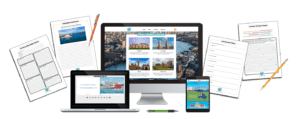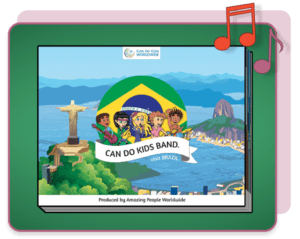International Education
- Can Do Kids Worldwide -
By Dr Charles Margerison
Psychologist
Countries and Cultures
Helping students understand and respect different ways of life in various countries is an important part of education.
Some students learn about this from experience, because their parents move from country to country with their work. Here are examples from people I know.
“My parents were born in South Africa. We moved to Australia when I was 10 years of age.”
“I lived the first 18 years of my life in France, where I was educated in French schools. At home, I spoke English, as my parents are from London.”
“My relatives are all in Canada, but I now live in England, where I am studying at university.”

These are just a few comments from people with personal experience of international education.
For those who do not have such opportunities, I have developed ways by which Primary students can virtually visit countries around the world. This article illustrates the principles and applications.
International Understanding
In today’s education landscape, schools have an increasing responsibility to help students better understand the ways of life in other countries. This is of significant importance, as our world becomes more culturally diverse, with the classroom often consisting of students from a vast range of cultural backgrounds from different countries, and who also have relatives around the world.
We therefore provide a proactive means of helping students to learn about ways of life in Asia, Africa, Europe, North and South American countries, plus those in the Pacific Ocean and Arabic speaking nations.
To be true citizens of the world, students should have access to tools for learning about the way of life for students in other countries.
We are supporting this via Can Do Kids Worldwide. This is an education resource suite that provides teachers and Primary level students with virtual visits to countries and gives them an opportunity to explore other cultures.
Explore the World
Can Do Kids Worldwide provides opportunities for students to travel the world in a virtual way. They can click on the flag of countries such as Brazil, USA, China, India, Australia and “fly through space”, to enjoy the music, dance and culture of those countries.
We have worked with teachers to develop interactive learning for students. This has led to positive results and specific feedback. Here are some of the comments:
 ‘I liked the education games, which enabled me to get passports of the countries that I visited,’ said a ten year old student.
‘I liked the education games, which enabled me to get passports of the countries that I visited,’ said a ten year old student.
Another added, ‘The video really helped me to understand the country of France,’
‘I liked the group discussions and presentations’, mentioned another 11 year old student. ‘That helped me improve my communication skills.’
Classroom Applications
In discussion with educators, we have developed two main ways of initiating intercultural learning.
Version A – Video and Group Discussion
If time for preparation is short, a teacher can start a class by showing a short video of a country and then organize classroom discussions. Here is a draft outline timetable for a 50 to 60 minute lesson.
 Introduction – 5 minutes.
Introduction – 5 minutes.
Teacher indicates the country to be studied and outlines the reasons why it is important. After seeing the five minute video about the named country, students will meet in groups of 4 or 5 to discuss the points arising.
- Video – 5 minutes.
The video of the selected country is shown.
- Group Discussions – 15-20 minutes.
Students are asked to appoint a chairperson to lead the discussion, and also a note taker. The task is to discuss the video and list key points arising that they wish to include in a travel brochure that will attract tourists.
- Presentations -15 minutes.
Each group outlines the key factors they have chosen, and indicates to whom they think their brochure will appeal.
- Review and Feedback -10 minutes.
The teacher provides feedback to each group both on their content and also the style of the presentation with the aim of supporting improvements.
Version B – Personal Preparation followed by Classroom Discussion
This version can be used when there is time available for students to explore the www.candokidsworldwide.com website
- Set Up – 5 minutes.
To establish the learning process, it is helpful to indicate the purpose by letting students know there will be group-based discussions on a country located selected from the website.
- Website Outline – 10 minutes
A walk-through of the website, starting with the login and access to the key pages is important. In particular, students should know how to find the Explorers Guide.
- Personal Preparation – 30 minutes
Each student makes time to work their way through the website. They should also be informed that they can gain the ‘passport’ to the chosen country by completing the exercises, which can be demonstrated. Also indicate to the students where they can complete the writing exercise. The preparation time required for students will vary, depending on the amount of written work required.
Classroom Session
Within a week of the students studying the Can Do Kids Worldwide website, there should be a classroom session. where they have the opportunity to share and compare what they have learned. This can link with topics such as Geography / SocialStudies / and Intercultural Education.
- Introduction – 5 minutes.
Students are allocated an exercise, to be discussed in groups based on the country they have studied. The exercise involves the priority issues about the country that they will include in:-
1 – Chapters of a book about the country.
2 – A video to be shown on TV about the country.
3 – A newspaper article about the country.
- Group Discussions – 15 minutes.
Students to meet in groups of four or five. Each group to appoint a chairperson and a note taker.
- Presentation Preparation – 10 minutes.
Students take the time to agree on how they will present the key points to the class.
- Class Presentations -15/20 minutes.
Each group makes their presentations.
- Review -10 minutes.
The teacher asks for comments on the group presentations and provides feedback.

Summary
These approaches have proven to be effective ways of engaging students in learning about people and places in foreign countries, and offer a means of widening their perspectives. The group discussions enable students to develop their communication skills, where they can be encouraged to share both facts and opinions, and distinguish between the two.
The range of countries available enables students to share and compare geographical and environmental locations. Charting each country on the world map helps students to perceive international distances and how geographical locations can affect, and indeed dictate some ways of living.
Can Do Kids Worldwide is an engaging education resources that enables students to virtually visit other countries and in doing so, students will better understand their own country.

Countries and Cultures
Helping students understand and respect different ways of life in various countries is an important part of education.
Some students learn about this from experience, because their parents move from country to country with their work. Here are examples from people I know.
“My parents were born in South Africa. We moved to Australia when I was 10 years of age.”
“I lived the first 18 years of my life in France, where I was educated in French schools. At home, I spoke English, as my parents are from London.”
“My relatives are all in Canada, but I now live in England, where I am studying at university.”

These are just a few comments from people with personal experience of international education.
For those who do not have such opportunities, I have developed ways by which Primary students can virtually visit countries around the world. This article illustrates the principles and applications.
International Understanding
In today’s education landscape, schools have an increasing responsibility to help students better understand the ways of life in other countries. This is of significant importance, as our world becomes more culturally diverse, with the classroom often consisting of students from a vast range of cultural backgrounds from different countries, and who also have relatives around the world.
We therefore provide a proactive means of helping students to learn about ways of life in Asia, Africa, Europe, North and South American countries, plus those in the Pacific Ocean and Arabic speaking nations.
To be true citizens of the world, students should have access to tools for learning about the way of life for students in other countries.
We are supporting this via Can Do Kids Worldwide. This is an education resource suite that provides teachers and Primary level students with virtual visits to countries and gives them an opportunity to explore other cultures.
Explore the World
Can Do Kids Worldwide provides opportunities for students to travel the world in a virtual way. They can click on the flag of countries such as Brazil, USA, China, India, Australia and “fly through space”, to enjoy the music, dance and culture of those countries.
We have worked with teachers to develop interactive learning for students. This has led to positive results and specific feedback. Here are some of the comments:

‘I liked the education games, which enabled me to get passports of the countries that I visited,’ said a ten year old student.
Another added, ‘The video really helped me to understand the country of France,’
‘I liked the group discussions and presentations’, mentioned another 11 year old student. ‘That helped me improve my communication skills.’
Classroom Applications
In discussion with educators, we have developed two main ways of initiating intercultural learning.
Version A – Video and Group Discussion
If time for preparation is short, a teacher can start a class by showing a short video of a country and then organize classroom discussions. Here is a draft outline timetable for a 50 to 60 minute lesson.
 Introduction – 5 minutes.
Introduction – 5 minutes.
Teacher indicates the country to be studied and outlines the reasons why it is important. After seeing the five minute video about the named country, students will meet in groups of 4 or 5 to discuss the points arising.
- Video – 5 minutes.
The video of the selected country is shown.
- Group Discussions – 15-20 minutes.
Students are asked to appoint a chairperson to lead the discussion, and also a note taker. The task is to discuss the video and list key points arising that they wish to include in a travel brochure that will attract tourists.
- Presentations -15 minutes.
Each group outlines the key factors they have chosen, and indicates to whom they think their brochure will appeal.
- Review and Feedback -10 minutes.
The teacher provides feedback to each group both on their content and also the style of the presentation with the aim of supporting improvements.
Version B – Personal Preparation followed by Classroom Discussion
This version can be used when there is time available for students to explore the www.candokidsworldwide.com website
- Set Up – 5 minutes.
To establish the learning process, it is helpful to indicate the purpose by letting students know there will be group-based discussions on a country located selected from the website.
- Website Outline – 10 minutes
A walk-through of the website, starting with the login and access to the key pages is important. In particular, students should know how to find the Explorers Guide.
- Personal Preparation – 30 minutes
Each student makes time to work their way through the website. They should also be informed that they can gain the ‘passport’ to the chosen country by completing the exercises, which can be demonstrated. Also indicate to the students where they can complete the writing exercise. The preparation time required for students will vary, depending on the amount of written work required.
Classroom Session
Within a week of the students studying the Can Do Kids Worldwide website, there should be a classroom session. where they have the opportunity to share and compare what they have learned. This can link with topics such as Geography / SocialStudies / and Intercultural Education.
- Introduction – 5 minutes.
Students are allocated an exercise, to be discussed in groups based on the country they have studied. The exercise involves the priority issues about the country that they will include in:-
1 – Chapters of a book about the country.
2 – A video to be shown on TV about the country.
3 – A newspaper article about the country.
- Group Discussions – 15 minutes.
Students to meet in groups of four or five. Each group to appoint a chairperson and a note taker.
- Presentation Preparation – 10 minutes.
Students take the time to agree on how they will present the key points to the class.
- Class Presentations -15/20 minutes.
Each group makes their presentations.
- Review -10 minutes.
The teacher asks for comments on the group presentations and provides feedback.

Summary
These approaches have proven to be effective ways of engaging students in learning about people and places in foreign countries, and offer a means of widening their perspectives. The group discussions enable students to develop their communication skills, where they can be encouraged to share both facts and opinions, and distinguish between the two.
The range of countries available enables students to share and compare geographical and environmental locations. Charting each country on the world map helps students to perceive international distances and how geographical locations can affect, and indeed dictate some ways of living.
Can Do Kids Worldwide is an engaging education resources that enables students to virtually visit other countries and in doing so, students will better understand their own country.







 Introduction – 5 minutes.
Introduction – 5 minutes.


